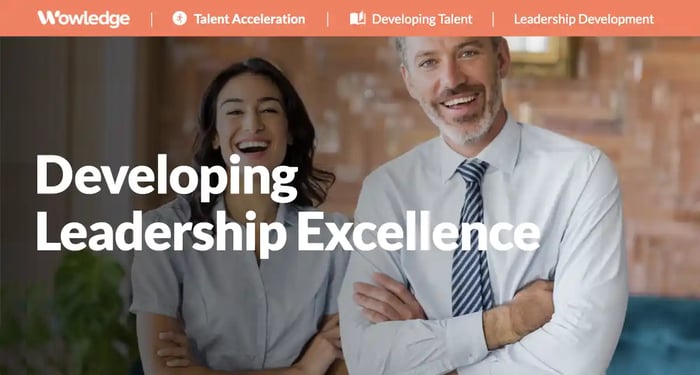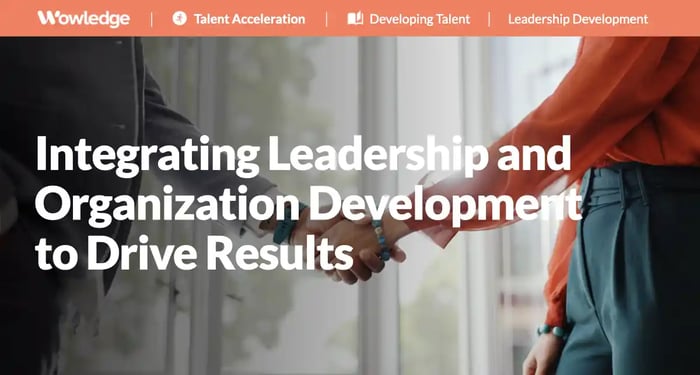Given the range of challenges that organizations face today, with global economic market disruptions, socio-political divisions, weaknesses in labor markets, generational shifts around work and workplace preferences, etc., it is no surprise that a focus on leadership effectiveness is sitting front and center. The role of leaders in fostering organizational success cannot be overstated, as they serve as the catalysts for innovation, employee engagement, and overall operational excellence. Despite the recognized significance of effective leadership, many companies confront issues such as leaders with skills gaps (e.g., people management, digital), and the ability to adapt to rapid changes in the business environment. Developing leadership excellence across the enterprise is a paramount concern.
The benefits of cultivating exceptional leaders are immense, ranging from increased employee productivity and engagement to enhanced strategic vision and adaptability. To overcome the challenges and unlock the full potential of their leadership teams, organizations must invest in a robust and impactful leadership development capability. This involves a series of strategic actions, including identifying and nurturing high-potential individuals, fostering a culture of continuous learning, and providing targeted and responsive leadership training programs. By embracing these initiatives, companies can fortify their leadership pipeline, foster a culture of excellence, and ultimately position themselves for sustained success.
The current state of leadership excellence
Great leadership matters – from the employee experience of the corporate culture to the organization’s financial results. While developing leadership excellence is a well-established priority, research shows a consistent trend of worker dissatisfaction with management. For example, DDI’s Global Leadership Forecast 2023 found that only 40% of companies rated the quality of their organizational leadership as “very good” or “excellent” (the lowest since 2011). A survey of over 5,000 employees and HR leaders found that 75% of employees said their managers were ineffective. Sadly, research jointly conducted by DDI, The Conference Board, and Ernst and Young found that only 14% of CEOs felt they had the necessary talent to execute their business strategies.
On the frontline of the employee experience, the quality of the relationship that workers at all levels have with their managers is measured directly by their satisfaction with the interactions, coaching, and direction received. And that experience is easily measured, as Gallup demonstrates with its widely used- and reported on “Q12” survey. Its data and analysis show that managers account for up to 70% of the variation in employee engagement scores. The trend is not good news for U.S. companies, with only 34% of surveyed employees reporting that they are “engaged” and 18% “actively disengaged.” The recent report pointed to managerial behaviors that are leading to the decline, including lower ratings (especially with younger workers) directly related to the relationship and interactions with one’s manager for:
- Clarity of expectations
- Feeling cared about
- Having someone who encourages their development
- Opportunities to learn and grow
- Their opinions counting
It’s a phenomenon that runs throughout the leadership ranks. As has been demonstrated over the years, Heidrick & Struggles found in a study of 20,000 executive searches that 40% of executives hired at the senior levels are forced out, fail, or quit within 18 months. While this is often attributed to a variety of reasons, such as poor cultural match, ineffective onboarding, or executive transition plans (overly aggressive change agendas or a lack of a quality support network), the reality is that such “organ rejection” may well be heavily influenced by some combination of such leaders’ own lack of emotional intelligence, adaptability, flexibility, and ability to listen and gather input. Such are the pressures of top leadership, where expectations that a newly hired or promoted executive has all the tools and resourcefulness needed from "Day One" are too common. A resulting lack of feedback and skill refinement often accelerates the downfall that otherwise might have been mitigated.
The pressures impact not only employees – the leaders themselves feel the heat when managing their responsibilities and teams. Their effectiveness is blunted by burnout, with 72% reporting that they experience feelings of being “used up at the end of the day”, up from 60% reporting the same in 2020. Perhaps worse is that only 15% feel prepared to prevent employee burnout, which, as we have covered in "The Cost of Employee Burnout", is a rapidly rising concern for organizations. A cadre of leaders who are ill-equipped to manage their own and their subordinates' sense of well-being and productivity represents an enormous challenge for any organization. And the newer (and now dominant) generations of workers in the labor force expect their mental health and well-being to be addressed in an accepted and constructive way.
The presence of toxic leaders makes matters worse. Studies have shown that the prevalence of “destructive” leaders sits at 13.6% that as many as 64% of employees are working for a toxic leader, and 36 - 44% of employees are being exposed to such leadership. Unfortunately, reports in psychological journals document the phenomenon of highly narcissistic employees being more likely to rise to higher levels of authority based on their behaviors and tendencies toward self-promotion and dominance “expected in higher-level positions”. The bottom line is that a certain percentage of leaders are likely acting in a manner that is not conducive to positive employee productivity, retention, and engagement. Dealing with those on a systemic basis is becoming an imperative.
Employee engagement as a measure of leadership and management quality
When we look at metrics that indicate good vs. poor people management, the way that engagement is measured in surveys gives a solid indication of the role of leaders in creating a positive work experience for people. Gallup’s approach, with its solidly built Q12 survey (developed based upon surveys of “over 2.7 million workers across 100,000+ teams”), asks 12 questions that are predictive of certain outcomes, including productivity, turnover, and profitability. Interestingly, it includes 8/12 questions that directly assess managerial behaviors, including:
- I know what is expected of me at work
- At work, I have the opportunity to do what I do best every day
- In the last seven days, I have received recognition or praise for doing good work
- My supervisor, or someone at work, seems to care about me as a person
- There is someone at work who encourages my development
- At work, my opinions seem to count
- In the last six months, someone at work has talked to me about my progress
- This last year, I have had opportunities at work to learn and grow
These point directly (and objectively) to a manager’s role related to the assignment of tasks, development of skills and capabilities, coaching, listening and feedback, providing guidance and business context, etc.
Similarly, McKinsey has found that what employees most care about are led by elements of a leader’s interactions, guidance, and actions that promote retention and engagement, including:
- Being valued by their manager
- Feeling a sense of belonging
- Work-life balance
- Manageable workload
At the core, while the picture might appear bleak, plenty of resources and practices can be adopted to build better leaders across the organization. What it takes is a disciplined approach to developing leadership excellence, the smart use of available budgets and resources, and a commitment from top business and HR leadership to listen, assess, and create a development culture.

The need for great leadership development
Great leadership is developed through robust and effective development. However, while most companies provide leadership and management development programming, many managers question their effectiveness, with 71 percent of managers reporting that they don’t receive support to improve as leaders of others. The structure of such training and development is neither properly aligned with business needs nor tailored to individual leaders’ development priorities. For example, from a survey of over 2500 HR leaders, 31% say that theirs have either a weak or no connection to strategic business plans, 50% indicate that the plans are not well-integrated, and 75% of their leaders are lacking effective development plans.
So, what steps do you take to create highly effective leadership development?
1. Develop and communicate a well-devised competency model
Developing leadership excellence starts with defining what it looks like. Standardized and well-communicated definitions of desired managerial capabilities provide a window through which aspiring leaders can understand what to develop and where to focus their behaviors, and most importantly, the organization can use them to assess current and future leaders and provide corrective development. Common leadership competencies cover functional, analytic, decision-making, and interpersonal interactions for a sufficiently broad set of skills required to manage all the senior or executive role elements. For example, research supports the notion of emotional intelligence as a driver of leadership success. In fact, emotional intelligence has been shown to be the strongest predictor of performance, accounting for 58% of success. Such emotional maturity, combined with similarly aware decision-making, are shown to be effective ways to assess future success as a leader of people.
2. Focus leaders and managers' ability to guide and support subordinates
Development should start early in a manager’s career, with offerings that establish foundational practices around communicating subordinate’s role expectations, providing performance feedback and direction, linking task assignments to the larger business objectives, listening and coaching, addressing personal challenges that slow progress towards work goals, recognizing successes, etc. As those requirements evolve in higher-level roles with larger groups of employees (and more levels between them), focusing mid-level and senior management towards broader communications skills and strategies, assessing middle managers, and translating business direction into functional or lower-level tactics are essential.
Interestingly, McKinsey’s Organizational Health Index (OHI), which measures an organization’s adoption and adherence to a set of management practices that are predictive of improved organizational outcomes, includes findings that the development of a “Leadership factory” that develops and deploys strong leaders at all levels drives a six-fold (6X) improvement in organizational health.
3. Simplify the manager role
We’ve talked about revitalizing the middle manager's role and improving their experience, and research supports that notion. McKinsey offers solutions that suggest a need for focusing on the manager experience as much as employee experience (EX) and candidate experience (CX) have become focus points for organizations. The focus should be on proactively engaging managers (and leaders) with reviewing, designing, and redesigning the systems, processes, and practices they are required to complete and participate in. Think of cycles and processes related to budgeting, performance management, purchasing, financial reporting, operational reviews, required meetings and reports, approvals, etc. Finally, make a formal review of spans of control a regular event, focusing on reducing task volumes and providing time for quality people coaching and management activity.
4. Redesign leadership and managerial development
Consider how leaders and managers absorb new skill development content and provide new pathways and vehicles to provide it where and when it is needed. Broaden the aperture of possibilities by updating education/training with in the moment (and digestible) micro-learnings that are organized and reinforcing in a disciplined manner via various formats. Provide YouTube-like videos that are produced by experienced peers on targeted subject matter. Establish ongoing group coaching and mentoring cohorts where learning with like-leveled peers across functions allow for both learning and teaching/coaching. Establish project and temporary assignments that provide experientially-based development for certain skills and competencies that will be useful to managers in different technical fields.
5. Focus efforts on the comprehensive development of “leaders at all levels”
The development of leaders is not a single event but rather a virtuous cycle of objective assessment, formal development, coaching and mentoring, carefully crafted and personalized career development and mobility. It takes time and years of observation and leadership agreement of an individual’s value and strengths relative to the challenges that leaders face, now and in the future.
Core to this is the early identification and ongoing development of a pool of workers with the potential to grow into leadership roles. The proactive oversight and management of supervisors, managers, and mid-level leaders can provide opportunities to directly observe, measure, and develop the capabilities of each individual to help them attain upward mobility that aligns with their actual “ceiling.” The creation and use of formal high potential (HiPo) programs, validated assessments, regular (“upward”) feedback from subordinates, performance calibration processes, and operational results evaluations bring greater objectivity into leadership promotion and assignment decisions.
6. Integrate leadership development to support requirements across talent management touchpoints
Link the desired competencies, values, and capabilities to reinforce the full range of talent processes that reinforce the message of their importance to one’s job performance and career progression. Integrate those into managerial selection processes (interview questions, role plays, reference checks), learning and development programming (courses, readings, podcasts, special assignments), performance management process (competency ratings, upward feedback), promotion and development assignment decisions (formal assessments in succession management calibrations), and career management (aspirational job assessments/requirements, development focus areas, etc.).
Have top leaders promote them in their own stories of how they demonstrated those throughout their career progression, how to draw upon them to meet current challenges, and how they relate to building the desired culture and achieving corporate objectives.
The lesson is that the development of leaders cannot be left to chance alone. Even great leaders need feedback and guidance to adjust and adapt their strategies and tactics to improve outcomes. Developing leadership excellence by ensuring that leadership guidance and development are linked to objective criteria, aligned closely with business plans and objectives, reinforced across the talent processes, used to hold all managers and leaders accountable, and championed consistently and regularly by top leaders, consistent and positive employee experiences and organizational success and stability can be achieved.
Relevant Practices & Tools
Core Leadership Development Practices to Define and Structure Leadership Capabilities. >
Leadership Development (LD) is the strategy and process of developing the key skills, capabilities, and styles needed by top leaders to successfully drive organizational performance... more »
Core Executive Transition Practices to Prioritize Strategic Goals for the Future. >
Over the past decade, much of the workforce has evolved into a more fluid, “gig-like” environment, taking advantage of internal and external opportunity marketplaces... more »
Creating Group Coaching and Mentoring Programs to Broaden and Syndicate the Potential for Impact. >
As a coaching and mentoring culture progresses, its effect is felt throughout the organization. The key at this level is to syndicate the use of coaching and mentoring deeper... more »
Developing Leaders Across Multiple Levels of Management. >
Advanced leadership development is designed to not only develop current executives, but "leaders" in all levels of the organization... more »
The Manager Coaching Feedback Survey Tool: Define and Apply Basic Questions for Employees Providing Feedback on Managers' Coaching Prowess. >
This tool functions as a guide to developing questions to assess the extent to which a line manager is providing quality coaching during regular performance check-in or formal discussions... more »
About Wowledge
Wowledge is the expert-driven platform for lean teams building strategic HR programs. Members enjoy access to up-to-date best practices, step-by-step guides, tools, templates, and insights to accelerate the design and implementation of all key HR programs and processes.
Since each organization has unique characteristics, needs, and aspirations, Wowledge's practices are developed utilizing an exclusive stage-based approach – from Core to Advanced to Emerging – that reflects distinct levels of sophistication to meet our members where they are.
Build strategic HR programs with refreshingly easy-to-follow best practices.
Get started for FREE! Learn more.










